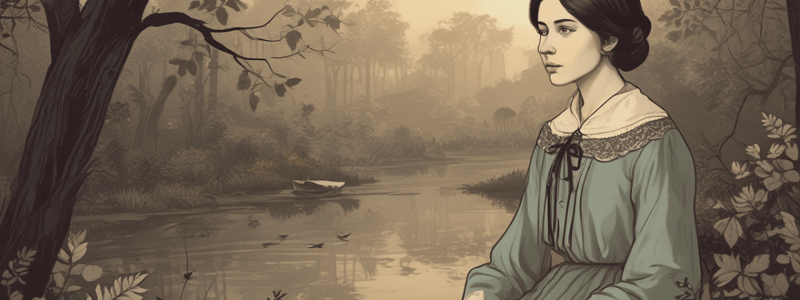Podcast
Questions and Answers
What literary device is used in the line 'The Stillness in the Room / Was like the Stillness in the Air –'?
What literary device is used in the line 'The Stillness in the Room / Was like the Stillness in the Air –'?
- Alliteration
- Metaphor
- Personification
- Simile (correct)
What is the author's tone in the poem?
What is the author's tone in the poem?
- Indifferent and detached
- Joyful and celebratory
- Somber and reflective (correct)
- Angry and aggressive
What literary device is used in the line 'The Eyes around – had wrung them dry –'?
What literary device is used in the line 'The Eyes around – had wrung them dry –'?
- Alliteration
- Simile
- Metaphor
- Synecdoche (correct)
What is the effect of the repetition in the poem?
What is the effect of the repetition in the poem?
What is the significance of the 'last Onset' in the poem?
What is the significance of the 'last Onset' in the poem?
What is the significance of the 'Heaves of Storm' in the poem?
What is the significance of the 'Heaves of Storm' in the poem?
What is the author's focus in the poem?
What is the author's focus in the poem?
What is the effect of the dashes in the poem?
What is the effect of the dashes in the poem?
What is the significance of the 'King' in the poem?
What is the significance of the 'King' in the poem?
What is the significance of the 'Fly' in the poem?
What is the significance of the 'Fly' in the poem?
What is the tone of the final stanza of the poem?
What is the tone of the final stanza of the poem?
Flashcards
Dickinson's 'I heard a Fly buzz –'
Dickinson's 'I heard a Fly buzz –'
Poem exploring themes of death, ceremony, and lack of control, characterized by precise language and vivid imagery.
Precise Language in Dickinson's poem
Precise Language in Dickinson's poem
Dickinson's use of precise language focuses on death and ceremony.
Repetition in Dickinson's poem
Repetition in Dickinson's poem
Dickinson utilizes repetition to stress and emphasize the atmosphere during death.
Synecdoche, pathetic fallacy, synaesthesia
Synecdoche, pathetic fallacy, synaesthesia
Signup and view all the flashcards
Fly in 'I heard a Fly buzz –'
Fly in 'I heard a Fly buzz –'
Signup and view all the flashcards
Juxtaposition in the opening line
Juxtaposition in the opening line
Signup and view all the flashcards
Stillness imagery in Dickinson's poetry
Stillness imagery in Dickinson's poetry
Signup and view all the flashcards
Emotional state of onlookers
Emotional state of onlookers
Signup and view all the flashcards
Speaker's final actions
Speaker's final actions
Signup and view all the flashcards
Study Notes
Poem Analysis
- The poem "I heard a Fly buzz – when I died –" by Emily Dickinson explores the themes of death, ceremony, and the lack of control over one's own death.
- The poem is characterised by a striking air of self-indulgence, as Dickinson imagines the moments before her own death.
Style and Imagery
- Dickinson's precise language focuses on the ceremony of death, creating a sense of tension and atmosphere in the room.
- The use of repetition attempts to capture the atmosphere in the room, emphasizing the precision of the moment.
- The poem employs synecdoche, pathetic fallacy, and synaesthesia to create vivid and striking imagery.
- Dickinson's trademark dashes add to the sense of tension and uncertainty in the poem.
Key Quotes and Analysis
- "I heard a Fly buzz – when I died –" : The opening line juxtaposes the ordinary act of hearing a fly buzz with the extraordinary moment of death.
- "The Stillness in the Room / Was like the Stillness in the Air –" : Dickinson compares the stillness in the room to the stillness in the air between the heaves of a storm, creating a sense of tension and uncertainty.
- "The Eyes around – had wrung them dry –" : Dickinson uses synecdoche to refer to the people around her deathbed as "Eyes", emphasising their emotional state.
- "I willed my Keepsakes – Signed away" : The speaker is getting their affairs in order, but is disrupted by the arrival of a fly.
- "With Blue – uncertain stumbling Buzz –" : Dickinson describes the sound of the fly in terms of color and movement, creating an unsettling effect.
Symbolism and Themes
- The fly may symbolise death, decay, or even the devil, adding to the sense of unease and uncertainty in the poem.
- The poem explores the idea of ceremony and paying respect to a loved one, as well as the inability to control one's own death.
- Dickinson's focus on the fly at the end of the poem creates a sense of distraction and disorientation, underscoring the theme of the uncertainty of death.
Studying That Suits You
Use AI to generate personalized quizzes and flashcards to suit your learning preferences.




